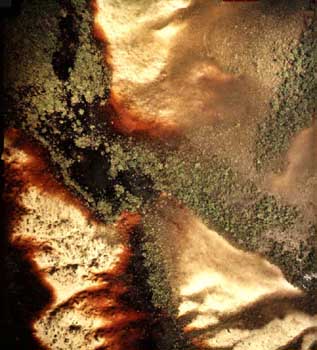
| Order | Index/Search | Home | About Us | Whats New |

|
|

|
Inspired by demonstrations of art and space technology at Brazil's National Institute for Space Research in the 1980s, José Wagner Garcia began to create complex installations exploring living systems. His key work, Amazing Amazon (1998), melds art, science, and technology to reconfigure the geography, geology, and aesthetics of the great South American river. (He has termed this project an "aesthetic geo-ontological exercise.") Wagner Garcia's alternative explorations of the river range from geological study of the ancient Paleolithic riverbed, rich in layered history, to the emerging evolution and scientific analysis of the contemporary river and basin. The multifaceted piece incorporates digital satellite maps, photographs, seismic studies, and other data to construct oversize installations of biological and geological segments of the river and its basin --- installations that are presented like a multipaneled wall painting. At the other extreme, his synoptic views of the Amazon taken by remote sensing satellite LANDSAT 5 reduce the gigantic river to a pattern of intersecting lines as delicate as human veins. These satellite photographs view the basin from three distances, using over 1,000 digital images and sound sequences to re-create the experience of the river in real time. Amazing Amazon contains multiple levels of meaning. In addition to the river as geologic phenomenon, it probes the river as semiotic process, as art, as history, and as an expression of the sublime. Thus the spectacle celebrates more than the geology and evolutionary action of the Amazon basin, it presents a multiplicity of scientific and aesthetic visions and alternative experiences of this river as both a natural force of the South American landscape and a formidable component of Earth's history. --Barbara Lee Williams, Leonardo/ISAST Awards Committee chairperson __________________________________________________ (artist questionnaire) Date of birth: March 6 1955 São Paulo Brazil Date and location of your first major exhibition: "metaholograms" at the "Bienal of São Paulo, Brazil, 1982 Location where you currently work (city and country): I am supported by 3 major Institutes in Brazil: INPE (National Institute for Space Research/Art and Space Technologies), UFScar University of São Carlos (Art and Bionanotechnology) and in my own studio/loft in the city of São Paulo How do you see technology changing art for the good or ill in the next decade?: In the way that science has "ethos" to create new forms of presenting the world (epistomology), we face "objects"---each time more complex (ontology). In other words, when the artist uses dynamic systems to create art, it shares new meanings with world intelligence. This new context is revolutionary because it puts the artist in contact with a new esthetic quality that is no longer different from the art of science. Scientific leaders have always been aware of the role of esthetics incorporated in the body of science. In this way, in the next decade, hybrid institutes such as The Santa Fé Institute and Media Laboratories of MIT will be the studios for a new artistic quality yet unknown by world culture. __________________________________________________ to learn more about José Wagner Garcia's work, visit this website http://www.uol.com.br/artecidade |